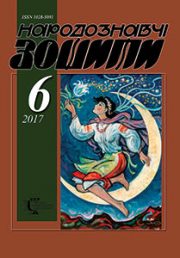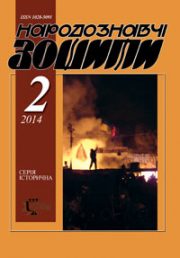The Ethnology Notebooks. 2022. № 2 (164), 501—516
UDK 930.2:[329.73:355.318](477.83-22)”194″
DOI https://doi.org/10.15407/nz2022.02.501
REBELLION MOVEMENT IN MEMORY OF PEASANTS OF SELISKO VILLAGE IN THE LVIV REGION
HORBAL Маrіa
- ORCID ID: https://orcid.org/0000-0001-9287-8336
- leading scientific editor,
- The Institute of Ethnology of the National
- Academy of Sciences of Ukraine,
- 15, Svobody Avenue, 79000, Lviv, Ukraine,
- Contacts: e-mail:horbal.m@gmail.com
Abstract. Formulation of the problem. In September 1939, the so-called liberation campaign of the Red Army in Western Ukraine ended. And immediately began a terrible repression against the same «Ukrainian bourgeois nationalists», that is — against the patriotic public, including young people. Members of the NKVD persecuted people not only for political activity, but simply for participating in cultural events. At the beginning of the German-Soviet war, Lviv prisons were overcrowded with Ukrainian citizens expressing their national position in any form.
The atrocities of the NKVD, the arrival of the new, German occupation authorities led to the mobilization of the Ukrainian population in the insurgent resistance movement. In October 1942, at a special military conference of the OUN, a decision was made to begin the creation of insurgent units, which were later renamed the Ukrainian Insurgent Army, UPA. UPA fought against both — German troops and the even more terrible «liberators», the Red Army. Every village in Western Ukraine was involved in the UPA.
The purpose of the article is through the prism of memories of the villagers. The village of Lviv region, now Pustomyty district, determined the involvement of peasants in the Ukrainian insurgent movement of the 1940s (chronological boundaries of the study).
Actuality of theme. The topic of the struggle for the establishment of Ukrainian statehood is more relevant than ever, during the war with the Russian occupiers. A fierce struggle was waged with the same occupiers 80 years ago in our region. And the coverage of the struggle for independence of Ukraine in one village is a brick in the history of the struggle for independence of the whole state.
Novelty of the article. For the first time in the history of the study of the insurgent movement in Western Ukraine, a large area of the insurgent detachment’s location, Bunkri, was discovered. This publication is an incentive for researchers of the insurgent movement to search for the UPA archives in this area.
The result of the study is to find the names of fighters for the independence of a particular village and their perpetuation through publication.
The research methodology is based on the application of the principles of scientificity, objectivity and historicism, and in the process of studying the material the method of historical reconstruction and field ethnographic research was used, in particular interviewing respondents.
Keywords: Ukrainian Insurgent Army, p. Village, Bunkry, the location of the insurgent detachment, self-sacrifice, courage, betrayal, slander.
Received 1.06.2022
REFERENCES
- Bloody Moscow: June 22, 1941 — the beginning of mass shootings in prisons of Western Ukraine. Retrieved from: https://uaua.top/23260/ [in Ukrainian].
- On the mass executions of political prisoners in NKVD prisons in Western Ukraine. Retrieved from: https://dailylviv.com/analytics/istoriya/pro-masovi-rozstrily-politychnykh-vyazniv-u-tyurmakh-nkvs-na-zakhodi-ukrayiny [in Ukrainian].
- Moroz, Volodymyr. Introduction Chronicle of the Ukrainian Insurgent Army. Military District of the UPA «Bug». Documents and materials 1943—1952 (Vol. 12, book 1) [in Ukrainian].
- Ukrainian Insurgent Army. Retrieved from: https://uinp.gov.ua/informaciyni-materialy/viyskovym/ukrayinska-povstanska-armiya [in Ukrainian].
- (1994). Sodol Peter. UPA 1943—49. Handbook. New York: Prologue [in Ukrainian].
- Moroz, Volodymyr (2012, april 11). Dmytro Soyka — «Nightingale». The Way of Victory [in Ukrainian].
- Melnik, Vasil (Ed.). (2005). Rohatyn in the struggle for freedom. Rogatyn [in Ukrainian].
- (2002). Chronicle of the Ukrainian Insurgent Army. Military District of the UPA «Bug». Documents and materials. 1943—1952 (Vol. 13, book 2). Toronto; Lviv [in Ukrainian].
- (2002). Chronicle of the Ukrainian Insurgent Army. Book of fallen members of the OUN and soldiers of the Ukrainian Insurgent Army of Lviv region (Vol. 36). Toronto; Lviv [in Ukrainian].
- (1934, June. From the life of Luhs. Seliska, pov. Lviv. News from Luh, 6 [in Ukrainian].
- Slyvka, Yu. (Ed.). (1996). Origins and consequences of the national tragedy. Deportations. Western lands of Ukraine in the late 30’s — early 50s. Documents, materials, memoirs (Vol. 1, pp. 5—26) [in Ukrainian].
- (2020). Census of population and its property in Selisko, Lviv region of 1940—1941 and 1950. Ethnographic notebooks, 4, 974—1009 [in Ukrainian].
- (1979). Anniversary book of the Ukrainian Academic Gymnasium in Lviv. Philadelphia; Munich [in Ukrainian].
- Archive of the Security Service of Ukraine in the Lviv region. Ref. P 51254 (Vol. 2, p. 120) [in Ukrainian].
- Komar, Ya.V. Rehabilitated Bulgarians in the Azov region. Retrieved from: http://dspace.nbuv.gov.ua/bitstream/handle/123456789/54961/Boychuk-41.pdf?sequence=1 [in Ukrainian].
- (2020). A tragedy in Tarasovo hamlet in the forest between Rakivets and Selysko in Pustomyty district, Lviv region mart 21st, 1944. The Ethnology Notebooks, 4, 1202—1212 [in Ukrainian].






